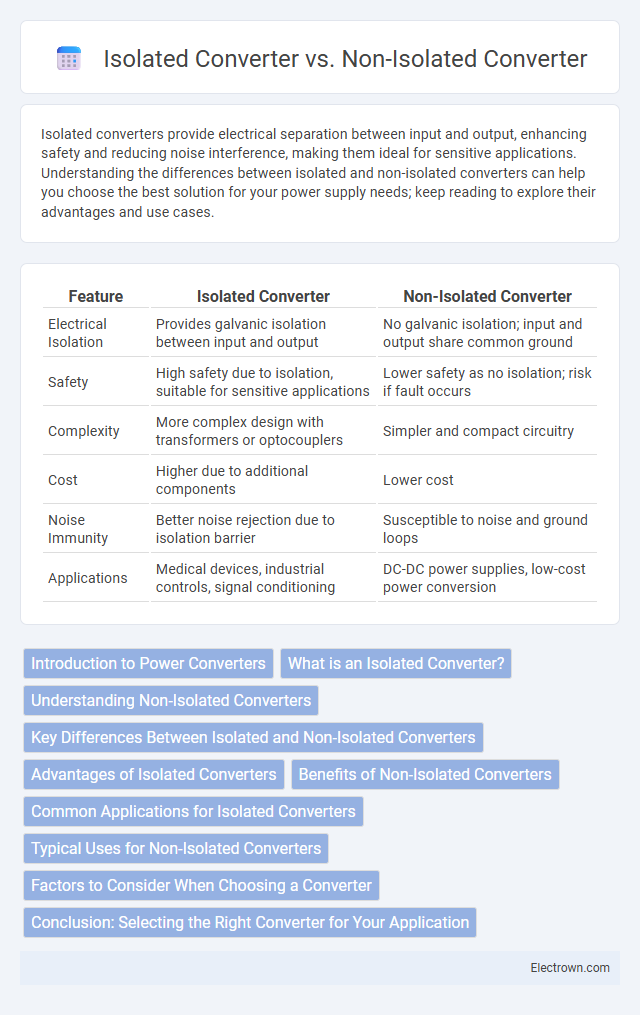Isolated converters provide electrical separation between input and output, enhancing safety and reducing noise interference, making them ideal for sensitive applications. Understanding the differences between isolated and non-isolated converters can help you choose the best solution for your power supply needs; keep reading to explore their advantages and use cases.
Table of Comparison
| Feature | Isolated Converter | Non-Isolated Converter |
|---|---|---|
| Electrical Isolation | Provides galvanic isolation between input and output | No galvanic isolation; input and output share common ground |
| Safety | High safety due to isolation, suitable for sensitive applications | Lower safety as no isolation; risk if fault occurs |
| Complexity | More complex design with transformers or optocouplers | Simpler and compact circuitry |
| Cost | Higher due to additional components | Lower cost |
| Noise Immunity | Better noise rejection due to isolation barrier | Susceptible to noise and ground loops |
| Applications | Medical devices, industrial controls, signal conditioning | DC-DC power supplies, low-cost power conversion |
Introduction to Power Converters
Power converters transform electrical energy from one form to another, classified as isolated or non-isolated based on electrical separation between input and output sides. Isolated converters use transformers to provide galvanic isolation, enhancing safety and noise reduction in applications like medical devices and industrial systems. Non-isolated converters offer higher efficiency and compact design by directly linking input and output grounds, commonly found in low-voltage DC-DC power supplies.
What is an Isolated Converter?
An isolated converter is a power electronic device that provides electrical separation between its input and output through a transformer, ensuring safety, noise reduction, and protection against ground loops. It enables voltage level shifting and galvanic isolation, which is critical in applications requiring system reliability and user protection, such as medical instruments and industrial controls. Unlike non-isolated converters, isolated converters prevent direct current flow between input and output, minimizing interference and enhancing overall system performance.
Understanding Non-Isolated Converters
Non-isolated converters share a common ground between input and output, resulting in simpler designs and higher efficiency for applications like DC-DC step-down or step-up power supplies. These converters lack galvanic isolation, which limits their use in scenarios requiring electrical separation for safety or noise reduction. Understanding non-isolated converters involves recognizing their cost-effectiveness and compact size, ideal for low-voltage systems where isolation is not critical.
Key Differences Between Isolated and Non-Isolated Converters
Isolated converters use transformers or optocouplers to provide electrical separation between input and output, enhancing safety and noise immunity, whereas non-isolated converters share a common ground, enabling simpler designs and higher efficiency. Isolated converters are preferred in applications requiring galvanic isolation, such as medical devices and industrial systems, while non-isolated converters are suitable for low-power, cost-sensitive tasks like point-of-load regulation. Thermal management and design complexity are generally higher in isolated converters due to additional components, contrasting with the compact, efficient nature of non-isolated types.
Advantages of Isolated Converters
Isolated converters provide enhanced safety by electrically separating input and output, reducing the risk of electric shock and equipment damage. They improve noise immunity and system reliability by preventing ground loops and minimizing electromagnetic interference. Their ability to handle higher voltages and offer flexible voltage conversion makes them ideal for industrial and medical applications.
Benefits of Non-Isolated Converters
Non-isolated converters typically offer higher efficiency and lower cost due to a simpler design without the need for transformers, making them ideal for applications with tight space and cost constraints. They provide faster transient response and lower leakage inductance, enhancing overall power conversion performance in DC-DC applications. Non-isolated converters are preferred for battery-powered and point-of-load power supplies where isolation from the input source is not a critical requirement.
Common Applications for Isolated Converters
Isolated converters are commonly used in medical devices, industrial automation, and communication systems where electrical isolation enhances safety and noise immunity. These converters protect sensitive components by preventing ground loops and reducing electromagnetic interference. Their key applications include powering sensors, control circuits, and data acquisition modules requiring reliable electrical separation.
Typical Uses for Non-Isolated Converters
Non-isolated converters are commonly used in applications where voltage levels require direct electrical connection between input and output, such as in point-of-load regulation for microprocessors, battery-powered devices, and LED drivers. They offer higher efficiency and simpler design compared to isolated converters but lack galvanic isolation, limiting their use in systems requiring safety isolation or noise reduction. Typical environments include DC-DC power supplies within tightly controlled systems where isolation is not a critical requirement.
Factors to Consider When Choosing a Converter
When choosing between isolated and non-isolated converters, key factors include safety requirements, voltage levels, and electromagnetic interference (EMI) considerations. Isolated converters provide galvanic isolation, crucial for protecting sensitive components and meeting regulatory standards in medical or industrial applications. Non-isolated converters offer higher efficiency and smaller size but may lack the necessary isolation for applications involving high voltages or noise-sensitive environments.
Conclusion: Selecting the Right Converter for Your Application
Isolated converters provide enhanced safety and noise reduction by electrically separating input and output, making them ideal for sensitive or high-voltage applications. Non-isolated converters offer higher efficiency and simpler design, suitable for low-voltage systems where isolation is not critical. Choosing the right converter depends on application requirements such as voltage levels, safety standards, and electromagnetic interference considerations.
isolated converter vs non-isolated converter Infographic

 electrown.com
electrown.com